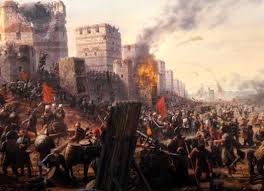 |
| Justinian's Constantinople |
The Turks are relative newcomers to Anatolia. They are part of a much larger linguistic group called ‘Turkic peoples’. This would include the Bulgars, Avars, Uyghurs, Uzbeks, Petcheneges, and possibly Huns among many others. They all seem to have originated in Central Asia, probably near the Altay mountain range where modern Russia, China, Mongolia, and Kazakhstan meet.
The Seljuk Turks started to migrate west as early as the 6th century
AD, but the main exodus took place in the 11th century when they were
pushed by the Mongols. In 1071 they crossed Byzantine territory
(Armenia) on their way to Egypt when the imperial army under Emperor
Romanus Diogenes confronted them at Manzikert. The resulting three day
battle was an almost unparalleled disaster for Byzantium. The army was
destroyed and Romanus himself was captured. Even worse, the Seljuks
(who had previously contented themselves with raiding) flooded into
Anatolia, permanently wrenching it from Constantinople. The Seljuk
empire, however, didn’t hold together for long. In 1299 a young Turk by
the name of Osman broke free from the collapsing Seljuks and founded
his own state which was named Ottoman in his honor.
 |
| Ottoman Empire (15th and 16th Centuries) |
By 1461 the Ottomans had absorbed the last remnants of Byzantium and
had pushed deep into Eastern Europe. Their empire would last until the
end of the First World War, at which time it was largely carved up by
the Great Powers. The areas where the Ottomans were ethnically dominant
(more or less) became the the borders of modern Turkey.








No comments:
Post a Comment